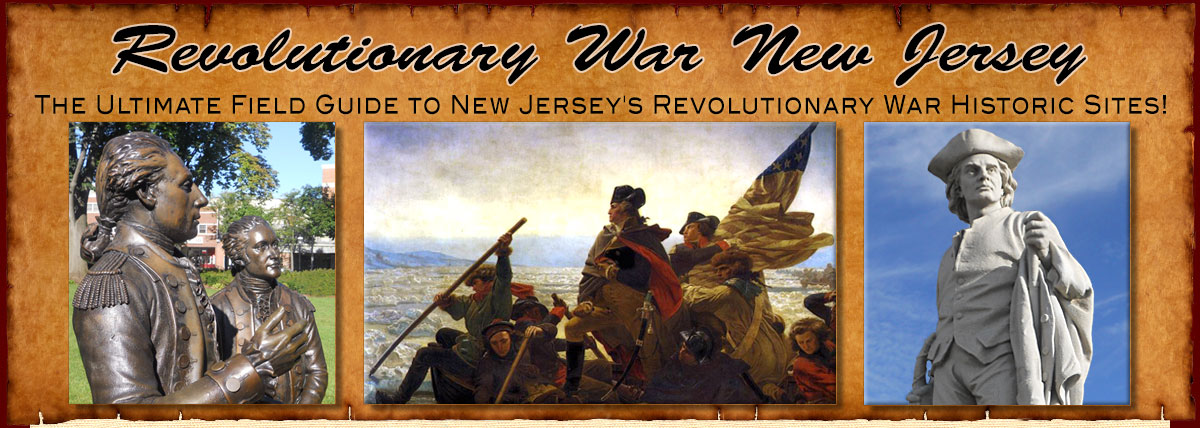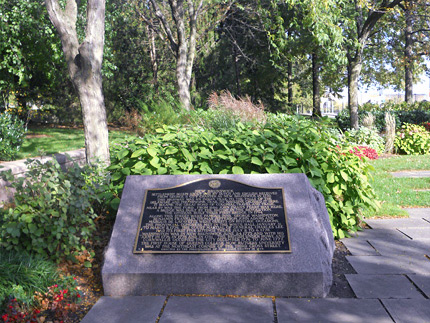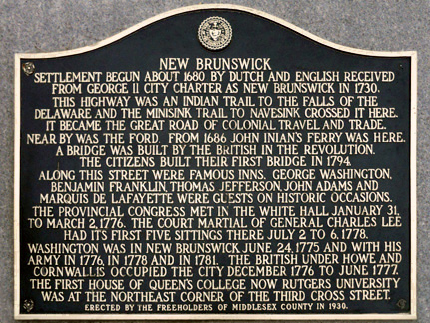



New Brunswick History Monument
Albany St. and Burnet St.
Map / Directions to the New Brunswick History Monument
Map / Directions to all New Brunswick Revolutionary War Sites
The plaque of this monument mentions a number of events in the history of New Brunswick, including some of Revolutionary War era significance: [1]
• George Washington passed through New Brunswick on June 24, 1775, en route to taking command of the Continental (American) Army in Cambridge, MA (See Albany and Neilson Streets entry below).
• The Provincial Congress of New Jersey met in New Brunswick from January 31 to March 2, 1776, at the White Hall Tavern, which was located on Albany Street.
• In September 9, 1776, Benjamin Franklin and John Adams stayed at the Indian Queen Tavern in New Brunswick. The building has been moved to East Jersey Olde Towne in neighboring Piscataway.
• American troops stopped in New Brunswick from November 29 - December 1, 1776, as part of their retreat across New Jersey from Fort Lee. While in New Brunswick, Washington used Cochrane's Tavern as his headquarters. (See Albany and Neilson Streets entry below.) On December 1, American troops attempted to destroy a bridge over the Rahway River connecting Piscataway and New Brunswick to slow the pursuit of the British and Hessian forces. They were only able to damage the bridge before being stopped by British and Hessian forces, who later repaired the bridge.
After General Washington and his troops left New Brunswick on December 1, the city was occupied by the British until June 1777.
• Following the Battle of Monmouth, General George Washington and the Continental Army were in New Brunswick from July 2 -7, 1778. During that time, the first sittings of the court-martial of General Charles Lee for his conduct at the Battle of Monmouth took place at the White Hall Tavern.• In early December 1783, weeks after the official end of the war, George Washington was honored at a dinner at the Indian Queen Tavern.
• In September 1824, French General Marquis de Lafayette, who had fought on the American side in the Revolutionary War, visited New Brunswick as part of his return trip to America from France in 1824/1825.
Frelinghuysen Marker / Washington Route Marker / Cochrane's Tavern Site
Markers are on the building at 78 Albany St.
Map / Directions to this site
Map / Directions to all New Brunswick Revolutionary War SitesThe building at the corner of Albany St. and Neilson St., which is now Due Mari restaurant, has three historic plaques, all with connections to New Brunswick's Revolutionary War history.
One plaque commemorates the first classes of Queen's College (Rutgers University) which were held in November 1771, in what had formerly been a tavern called the Sign of the Red Lion. The first tutor was Frederick Frelinghuysen (1753 - 1804). [2] Although the plaque does not mention it, Frelinghuysen went on to become an officer in the Revolutionary War. He is buried in Van Nest Burying Ground in Hillsborough Township. The Sign of the Red Lion was located diagonally across the street from here on what was then the northeast corner of Albany and Neilson streets. That northeast corner no longer actually exists because that corner's location is now taken by part of the Johnson & Johnson property.
A second plaque marks the route General Washington took from Philadelphia to Cambridge, Massachusetts, in 1775 to assume command of the Patriot Army. [3] On June 15, he had been appointed Commander in Chief of the Continental army by Congress in Philadelphia. He would arrive in Cambridge to take command of the army on July 3. Another plaque marking Washington's 1775 route is located in Trenton.
A third plaque states, "Under the rooftree of the inn which occupied this site General Washington tarried when in New Brunswick." This refers to Washington's use of Cochrane's Tavern, which was located at this corner, as headquarters from November 29 - December 1, 1776, during the army's retreat across New Jersey from Fort Lee. The plaque goes on to state, "On the adjoining square upon the arrival of the express rider The Declaration of Independence was acclaimed by all loyal citizens on July 9, 1776. New Brunswick was the third town in which the document was read." [4] The actual reading of the Declaration of Independence in New Brunswick took place at Christ Church. (See next entry below.)
Christ Church
5 Paterson St.
Map / Directions to Christ Church and Cemetery
Map / Directions to all New Brunswick Revolutionary War SitesOne of the earliest public readings of the Declaration of Independence was made at the foot of the church tower on July 9, 1776. Although the plaque on the church states that it was the third public reading, this is an error. There were three public readings the day before, in Trenton, Philadelphia, and Easton, Pennsylvania.) [5]
Brigadier General Anthony Walton White (July 7, 1750 - February 10, 1803) is buried in the cemetery. A plaque on his table gravestone states they he was "A member of General Washington's staff. Washington, Lafayette and Kosciuszko called him friend." [6] White grew up at Buccleuch Mansion in New Brunswick. (See entry lower on this page)
The cemetery contains the grave of several other Revolutionary War soldiers, including: [7]
Captain George Farmer
Captain John Hodge
Died April 7, 1798, aged 65Stephen Kemble
1740-1822
Loyalists who fought on the side of the British
Lt. Colonel - First Battalion of the 60th (Royal American) Regiment
Alexander Hamilton Artillery Battery Site
Rutgers University Campus
George St. and Somerset St.
Map / Directions to the Alexander Hamilton Artillery Battery Site
Map / Directions to all New Brunswick Revolutionary War SitesDuring the retreat across New Jersey that had begun at Fort Lee on November 20, 1776, Washington and his troops stopped at New Brunswick from November 29 through December 1. Washington had hoped to engage the British in battle here, but he decided that his own troops were not in the condition to do so, and he decided to move forward through Princeton and to Trenton.
On December 1, Alexander Hamilton's artillery battery was positioned here, providing cover for Washington's troops to continue their retreat. Hamilton's battery engaged in an artillery duel with the British who were on the other side of the Raritan River. This delayed the British advance and allowed Washington's troops to withdraw.
Captain Enoch Anderson later remembered, "A severe cannonading took place on both sides, and several were killed and wounded on our side." [8]
If you enter through the gate at George Street and Somerset Street, the site will be on the hill to your right, on the side of Kirkpatrick Chapel. It is marked with a sign erected by the Rutgers class of 1899.
Men of Rutgers College Marker
Old Queens Building / Rutgers University Campus
George St. and Somerset St.
Map / Directions to the Men of Rutgers College Marker
Map / Directions to all New Brunswick Revolutionary War SitesA short walk from the Alexander Hamilton Artillery Marker is the Old Queens Building. A plaque at the entrance pays tribute "to the memory of the men of Rutgers College who fought for the cause of Independence in the American Revolution." [9]
FIRST REFORMED CHURCH CEMETERY
First Reformed Church Cemetery
9 Bayard St.
Map / Directions to the First Reformed Church Cemetery
Map / Directions to all New Brunswick Revolutionary War SitesThis church was constructed in 1811 -1812. [10]
Revolutionary War soldiers are buried in the cemetery, including: [11]
David Abeel
Died October 30, 1840, aged 77Abraham Bennett
(1747 - 1839)
Ordnance Sergeant - Continental LineJohn Boice
(1745 - 1778)
Middlesex County MilitiaGarrett Nevius
Private - NJ Continental Line
1754 - 1830John Powers
Captain of a company of North Carolina militia
Died March 1831Jasper Provost
Died July 5, 1854, aged 92John Van Deventer
Fifer - Middlesex County NJ Militia
1756 - 1846John Van Liew
Private - 2nd Regiment NJ Militia
December 19, 1756 - May 18, 1830BUCCLEUCH MANSION Buccleuch Mansion
800 George St.
Map / Directions to Buccleuch Mansion
Map / Directions to all New Brunswick Revolutionary War SitesFor current hours and admission information, see the Buccleuch Mansion web page
A plaque on the house explains its Revolutionary War history: [12]"Built about 1735 and occupied until 1774 by Anthony White, whose wife was Elizabeth, Daughter of Governor Lewis Morris, and whose son was General Anthony Walton White.
"Owned and occupied from 1774 by General William Burton of the British Army.
"Owned by the Commissioners of Forfeited Estates 1776-1783. Occupied in 1775 by Colonel George Janeway, and in 1777 while the British occupied the city by the Enniskillen Dragoons."Owned and occupied 1783 - 1798 by Colonel and Commissary General Charles Stewart."
There are still saber and musket marks on the floors and banisters of the house, from the time when it was occupied by British soldiers. After the war, when the house was owned by Col. Charles Stewart, it was visited by George Washington, Alexander Hamilton, General Thaddeus Kosciusko, General Horatio Gates, and John Hancock. [13] Stewart, who had served as General Washington's Commissary-General in the war, had another home in Franklin Township (Hunterdon County). He is buried at the Bethlehem Presbyterian Church Cemetery in Pittstown)
General Anthony White, who grew up in this house, is buried in New Brunswick's Christ Church Cemetery. (See entry above on this page.)
HENRY GUEST HOUSE
Henry Guest House Museum
58 Livingston Ave.
Map / Directions to the Guest House
Map / Directions to all New Brunswick Revolutionary War SitesThis house was built in 1760 by Henry Guest. Guest was strongly committed to the cause of Independence, and he corresponded with both John Adams and Thomas Paine. Paine, the author of Common Sense and The Crisis, stayed here in 1776.
Henry's son, Captain Moses Guest served in the Revolutionary War, and he was involved in the capture of British Lieutenant-Colonel John Simcoe, Commander of the Queen's Rangers.
The Guest house originally stood about a tenth of a mile northeast of here, on Carroll Place (now called New Street) between Livingston Ave and George St. It was moved to its current location, next to the New Brunswick Public Library, in 1925. [14]
1. ^ The monument/plaque was erected by the Freeholders of Middlesex County in 1930.
• The bulleted items listed in the entry text are all mentioned on the plaque. However, additional information and clarification has been added. More information, and accompanying source notes, can be found for some of these events on the pages linked to within the text.
• The presence of General George Washington and the Continental Army in New Brunswick from July 2-7, 1778 is established in Washington's documents from this period.
His General Orders for July 1 state that the army was to march to Brunswick the following day, July 2.
His documents from July 2-7 are marked "Brunswick."
His General Orders for July 6 state that the army was to march out of Brunswick on July 7
▸ These documents are available to be read at the Founders Online / National Archive website here
• Regarding the sessions of the court-martial of General Charles Lee in New Brunswick, see:
Proceedings of a General Court-Martial Held at Brunswick, in the State of New-Jersey, by Order of His Excellency Gen. Washington, Commander-in-chief of the Army of the United States of America, for the Trial of Major-General Lee, July 4th, 1778 (New York: J. M. Bradstreet & Son, 1864) p. 4-35
Available to be read at the Internet Archive here
▸ Although the New Brunswick history monument states, "had it's first five sittings there July 2 to 6, 1778," the minutes show that no actual proceedings took place on July 2 and 3. The actual proceedings began on July 4 and were held in New Brunswick that day, and then again on July 5 and 6.
Proceedings resumed several days later at the Old Paramus Reformed Church in what is now Ridgewood.
• Regarding the Provincial Congress of New Jersey meeting in New Brunswick, see:
Minutes of the Provincial Congress and the Council of Safety of the State of New Jersey (Trenton: Naar, Day & Naar, 1879)
Available to be read at Google books here
▸ Pages 325-426 provide the names of the deputies (delegates) who attended the New Brunswick sessions
▸ Pages 339-407 provide the minutes of the sessions held in New Brunswick• For an account of Lafayette's visit to New Brunswick in 1824, see:
"Lafayette In New Brunswick in 1824," Proceedings of the New Jersey Historical Society, Volume V, No. 1, January 1920 (Newark, 1920) p. 112-116 Available to be read at Google Books here
▸ I found it difficult to determine the exact date of Lafayette's visit in New Brunswick, but it was likely September 25. Due to my uncertainty, I left it as simply "September 1824" in the main entry above.
▸ Information about of some of Lafayette's other stops in New Jersey during his 1824/1825 visit to America, along with accompanying source notes, can be found on the Elizabeth, Hackensack, Morristown, Paramus and Woodbridge pages of this website.2. ^ Information drawn from:
• Plaque erected by the Society of Colonial Wars in the State of New Jersey, November 2012
• A Historical Sketch of Rutgers University by Rutgers University Archivist Thomas J. Frusciano, available to be read on the Rutgers University Libraries website3. ^ Erected by the New Jersey Society Sons of the American Revolution, June 24, 1914
4. ^ Sign erected by The Jersey Blue Chapter Daughters of The American Revolution, 1913
• Some of Washington's correspondence from his time here (Marked as "Brunswic" [sic] or "Head-Quarters Brunswic" [sic]) can be read in:
George Washington; Edited by Jared Sparks, The Writings of George Washington Volume 4 (Boston: Russel, Odiorne and Metcalf; and Hilliard, Gray, and Co., 1834) p. 193-199
Available to be read at Google Books here5. ^ Historic plaque on the church
6. ^ Plaque erected by The Jersey Blue Chapter - Daughters of the American Revolution 1908
7. ^ Information from gravestones and markers in the cemetery
• Stephen Kemble information from the Biographical Note to the Stephen Kemble Papers, 1780-1793 (Manuscripts Division William L. Clements Library University of Michigan) Available to be read at the website of the University of Michigan / William L. Clements Library website
8. ^ Ron Chernow, Alexander Hamilton (New York: The Penguin Group, 2004) p.83-84
and
David Hackett Fischer, Washington's Crossing (New York, Oxford University Press, 2004) p.130-131
The quote from Captain Anderson is from Personal Recollections of Captain Enoch Anderson, an Officer of the Delaware Regiments in the Revolutionary War Pg 25, which is included in:
Historical and Biographical Papers, Historical Society of Delaware, Volume 2 (Wilmington: Historical Society of Delaware, 1895) Available to be read at Google Books here
• Anderson does not mention Hamilton by name. He does state that he was "under the Command of Lord Stirling." Hamilton's Artillery Battery was also part of Lord Stirling's brigade.
• Anderson states that "In the afternoon of the fifth of December, I think, the British appeared on the bank of the Raritan River." [emphasis added]
However, it appears that Anderson was incorrect in remembering the date, and that it actually occurred on the first. Anderson himself made the point that he was uncertain about the date, by writing, "I think".9. ^ Plaque erected by the New Jersey Society of the American Revolution on November 10, 1916, the 150th anniversary of the founding of Rutgers college
10. ^ Historical information plaque in front of the church
11. ^ Names, dates, and military information from gravestone and markers in the cemetery
12. ^ Plaque on Buccleuch Mansion
13. ^ New Jersey Daughters of The American Revolution / Jersey Blue Chapter, website - Buccleuch Mansion page
14. ^ Information about Henry and Moses Guest, and the Guest house, was drawn primarily from the Henry Guest House section of the Archives of The New Brunswick Free Public Library website.
▸ If you visit these online Archives, look under the "Digital Archives" tab to see a copy of an original letter written from John Adams to Henry Guest in 1811.
• The "Poems and Journal" of Captain Moses Guest were published in 1823, which included an account of Guest's role in the capture of Simcoe. A description of this was included in:
"The Capture of Lieutenant-Colonel Simcoe, Commander of the Queen's Rangers," in Eugene F. McPike, ed., Tales of our Forefathers and Biographical Annals of Families Allied to Those of McPike, Guest and Dumont (Albany NY: Joel Munsell's Sons, Publishers, 1898), 9 -19.
Available to be read at the Internet Archive here.